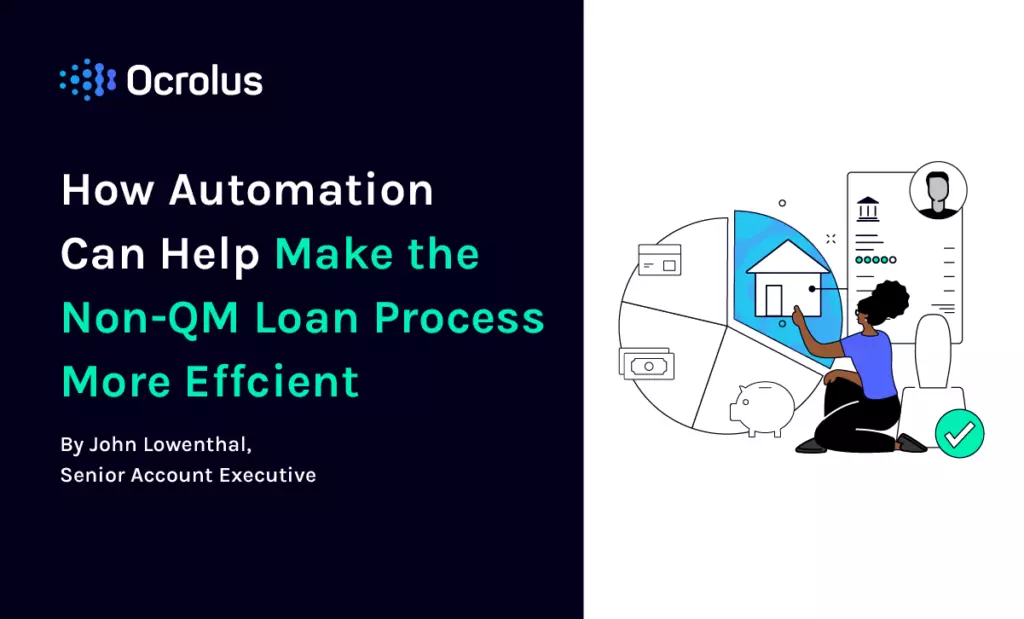This website uses cookies so that we can provide you with the best user experience possible. Cookie information is stored in your browser and performs functions such as recognising you when you return to our website and helping our team to understand which sections of the website you find most interesting and useful.
How Mortgage Automation Can Increase the Viability of Non-QM Loans

Homebuyers with erratic income streams, a debt-to-income (DTI) ratio higher than 43%, or a short credit history often have unique financial situations that preclude them from meeting the requirements for a qualified mortgage (QM), but that shouldn’t necessarily rule them out as low-risk borrowers.
Lenders in today’s marketplace understand that some customers are viable mortgage loan applicants – even if they don’t meet the consumer protection thresholds defined by Congress in the 2010 Dodd-Frank Act. New pricing opportunites and improved automation for underwriting promises to help fintechs meet a growing demand for non-QM loans.
Increasing Value of the Non-QM Market
While QM loans provide lenders with some additional liability protection, there is still a strong market for non-QM loans. Moreover, a revised qualified mortgage rule issued by the Consumer Financial Protection Bureau establishes a pricing threshold to replace the 43% DTI limit. That could expand funding options for non-qualified mortgage borrowers, especially with government-sponsored enterprises, Fannie Mae and Freddie Mac, embracing the new rule.
The combination of a revised DTI limit and government-backed non-QM loans is expected to give non-traditional borrowers more choices. S&P Global predicts that non-QM loan volume – which slowed during the pandemic – will increase from $12 billion a year to $25 billion by the end of 2021. The S&P analysis also underscores the fact that non-QM loans are not necessarily high risk. The average borrower’s FICO score is about 700 and the average Loan to Value (LTV) ratio is around 70%.
Borrowers who apply for non-qualified mortgages are often young, self-employed, or investors interested in purchasing rental or vacation properties. Non-QM loans also come into play when borrowers don’t have perfect credit – such as a past bankruptcy – or when they want an interest-only mortgage.
Legacy banks tend to prefer mainstream QM loans, leaving the non-QM lane open for other lenders. This gives non-traditional fintechs an opportunity to gain market share.
Growing Number of Non-traditional Borrowers for Non-QM Loans
The COVID-19 pandemic has disrupted the job market and the number of self-employed is rising as people opt not to return to traditional brick and mortar jobs. In addition, an increasing number of gig economy workers is also swelling the ranks of borrowers interested in non-QM loans. Many of those newly independent workers have strong personal balance sheets, but don’t meet the requirements for a qualified mortgage.
That means there is a growing market of highly qualified non-QM borrowers. But lending to non-QM borrowers still requires due diligence to protect against default. Minimizing risk when underwriting non-QM loans requires the ability to fully assess a borrower’s financial condition. That means lenders have to carefully verify income sources, assets, identity and liabilities. Automation can help with the documentation process and can facilitate aggregating information into one, standardized document.
Full documentation typically requires pay stubs, W-2s, and tax returns. Non-QM lenders need to consider alternative income documentation, such as personal and business bank statements, and personal financial statements that detail assets and liabilities.

Additional documentation required often depends on the borrower’s financial situation and the property being purchased. Lenders might, for example, want everything from proof of homeowners and flood insurance to investment income statements and details on principal, interests, taxes, and insurance (PITI) on other properties a borrower owns.
For lenders, meeting underwriting and compliance requirements can be a costly, tedious, and time-consuming process. Lenders have to review and verify non-standard documents in order to verify the accuracy and completeness of applications from borrowers. That process can be time-consuming and often requires manual review.
Automating Mortgage Review with Artificial Intelligence
One way in which non-QM lenders can reduce costs – and risk – is by implementing automated mortgage review processes that use artificial intelligence and advanced analytics to streamline mortgage origination, closing, and servicing. Automation can be especially useful in reducing the time it takes to review non-standard documentation.
An automated underwriting system (AUS) can help lenders better understand the nuances of an unconventional borrower’s financial picture. Mortgage automation also can help to ensure that borrowers meet specific non-QM underwriting requirements while reducing the need for manual review. In addition to automating the document review process, automation can also be used for compliance and to create audit trails.

Non-QM lenders can also customize their AUS to reflect their own underwriting requirements, and facilitate an automated review based on the unique needs of their financial institution. Improved efficiency, less manual review, and more accuracy can translate into fewer mistakes and better loan decisions.
Because non-QM loans are higher risk, non-QM lenders need to optimize process efficiencies in order to minimize bad loans and defaults. Machine learning, with human-in-the-loop (HITL) oversight, can produce better results than manual review, and that results in stronger underwriting. HITL uses human experts to validate machine learning models on-the-fly. AI also can flag data anomalies in order to identify fraud.
For tech-savvy lenders, the non-QM market offers a golden opportunity to increase market share without competing directly with legacy banks. AUS gives fintech lenders the ability to increase their risk exposure while still adhering to underwriting guidelines that ensure that non-conforming loans benefit both the lender and the borrower.
Learn more about how loan mortgage automation solutions from Ocrolus enables companies to scan a wider array of documents faster and detect fraud — providing a way to streamline the review of non-QM borrowers. You can also visit our FAQs to learn more about general mortgage automation frequently asked questions.”





